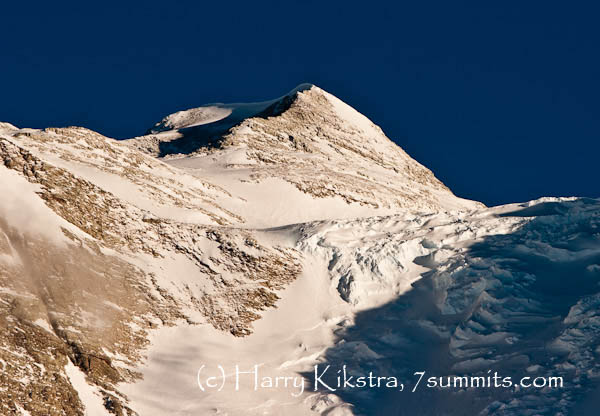|
|
Vinson
Summit
of
Antarctica,
4897m
The
last
continent
is
a
cold
one...
and
on
average
the
highest
as
well!
Mt
Vinson
is
the
highest
point
and
therefore
one
of
the
7
summits
So
to
climb
the
7
summits,
one
must
go
to
the
bottom
of
the
earth...

Vinson
Massif,
at
78°35'S,
85°25'W
is
21km
(13
miles)
long
and
13km
(8
miles)
wide.
It
lies
on
the
southern
part
of
the
main
ridge
of
the
Sentinel
Range.
Named
for
Carl
G
Vinson,
a
Georgia
congressman
and
a
major
force
in
20th
century
US
Antarctic
exploration,
it
was
first
climbed
in
December
1966
by
a
combined
group
from
the
American
Alpine
Club
and
the
National
Science
Foundation.
Four
members
of
the
joint
expedition
led
by
Nicholas
B.
Clinch
made
the
first
ascent
of
the
mountain
on
17
December
1966.
During
the
next
days
the
team
continued
climbing
in
the
local
area
adding
Mount
Tyree
(4845m/15,892ft),
Mount
Shinn
(4801m/15,747ft)
and
Mount
Gardner
(4686m/15,370ft).
Vinson
Massif
–
Facts
| Discovered |
1957,
after
being
sighted
by
US
Navy
aircraft. |
| Height |
4897m
(16,067ft).
It
is
also
13km
(8
miles)
wide |
| Location |
78°35’S,
85°25’W.
Part
of
the
Sentinel
Range
and
1200km
(746
miles)
from
the
South
Pole. |
| History |
Vinson
Massif
was
named
after
Carl
G.
Vinson,
a
US
congressman
who
persuaded
the
US
Government
to
pledge
support
for
exploration
of
Antarctica
in
the
20th
century.
The
mountain
was
first
climbed
by
a
US
expedition
team
sponsored
by
the
American
Alpine
Club.
They
reached
the
summit
at
11.30am
on
18
December
1966
–
the
first
of
many
climbing
teams
who
would
come
to
conquer
Antarctica’s
highest
peak.
Adventure
Network
International
first
arranged
a
climb
of
Vinson
Massif
in
1984.
The
expedition
was
unsuccessful
due
to
weather
and
engine
problems,
but
in
1985,
Adventure
Network
International
organised
and
completed
three
successful
expeditions.
Since
the
inception
of
the
Vinson
Massif
climbing
program,
Adventure
Network
International
has
taken
over
500
clients
to
the
top
of
this
coveted
Seventh
Summit. Adventure Network was aquired by Antarctic Logistics who continued the
services, up til beginning of 2005 about 950 people have summited Mt Vinson.
(From
Damien Gildea's Shinn report of te Omega Foundation:) "Mt. Shinn has long
been considered Antarctica’s third highest mountain. The first surveys of the
Ellsworth Mountains were done by US parties during the 1961-62 season, when the
first ascents of mountains in the range were also done. The area was re-surveyed
in the 1979-80 season, again by a US party. This expedition included, however,
two German and one Soviet climber, who climbed to the summit of Vinson Massif in
the course of their work. They placed a ski-pole and red flag on the summit,
which assisted the ground parties in obtaining a height for Vinson that was more
accurate than had previously been ascertained. Thus the height of Vinson’s main
summit was reduced from 5140m to 4897m. The official height of Mt. Tyree was
also reduced to 4852m, but no height was ever published for Mt. Shinn – either
before or after the 1979 work." Shinn was measured by Gildea and found to be
4661m. |
Antarctica
Facts:
- Antarctica
is
the
Earth's
5th
largest
continent,
measuring
14
million
square
kilometres
(5.4
million
square
miles).
- The
ice
sheet
that
covers
almost
all
of
Antarctica
is
the
largest
body
of
fresh
water
on
earth,
containing
about
90%
of
the
world's
ice
and
68%
of
the
fresh
water.
- If
Antarctica's
ice
sheet
were
to
melt,
it
would
raise
the
level
of
the
world's
oceans
about
60
metres
(200
feet).
- The
thickest
part
of
the
ice
sheet
extends
about
4,800km
(2980nm)
(15,700
feet)
into
submerged
basins
in
the
rock.
- Antarctica
has
the
greatest
average
elevation
of
any
continent
at
1,860
metres
(6,100
feet).
The
average
elevation
of
North
America
is
720
metres
(2,300
feet).
- The
highest
mountain
on
the
continent
is
Vinson
Massif,4,897
metres
(16,067
feet),
situated
in
the
Ellsworth
Mountains (see the waypoints page for details about
variation of the measurements).
- The
snow
fall
in
Antarctica
is
so
minimal
that
the
continent
has
been
called
"the
world's
coldest
desert".
The
interior
receives
less
than
3
cm
(1
inch)
of
precipitation
a
year,
making
it
the
driest
continent
on
Earth.
- The
Antarctic
dry
valleys
in
Victoria
Land
are
among
the
driest
places
on
Earth.
Some
scientists
believe
that
no
rain
has
fallen
there
for
two
million
years.
Astronauts
have
visited
the
dry
valleys
because
of
their
similarity
to
lunar
landscapes.
- Mean
temperatures
in
the
inland
during
the
coldest
month
from
-40
F
to
-94
F
and
in
the
warmest
month
from
5
F
to
-31
F.
At
the
coasts,
the
temperature
ranges
between
5
F
to
-22
F
in
winter
and
about
32
F
in
summer.
On
July
21,
1983,
the
Soviet
station,
Vostok,
reported
a
record-breaking
128.6
F
below
freezing.
- During
winter
months,
low
temperatures
cause
much
of
the
seas
around
Antarctica
to
freeze.
At
maximum
sea
ice
covers
an
area
larger
than
the
continent
itself.
- The
South
Pole
experiences
a
six
month
period
of
darkness
in
winter
and
a
six
month
period
of
sunlight
in
summer.
- Antarctica
is
the
only
continent
in
the
world
with
no
permanent
or
indigenous
human
inhabitants.
Larger
than
the
United
States,
the
frozen
land
is
populated
by
approximately
2,500
people
during
the
summer
and
fewer
than
1,000
in
the
winter.
|
|

